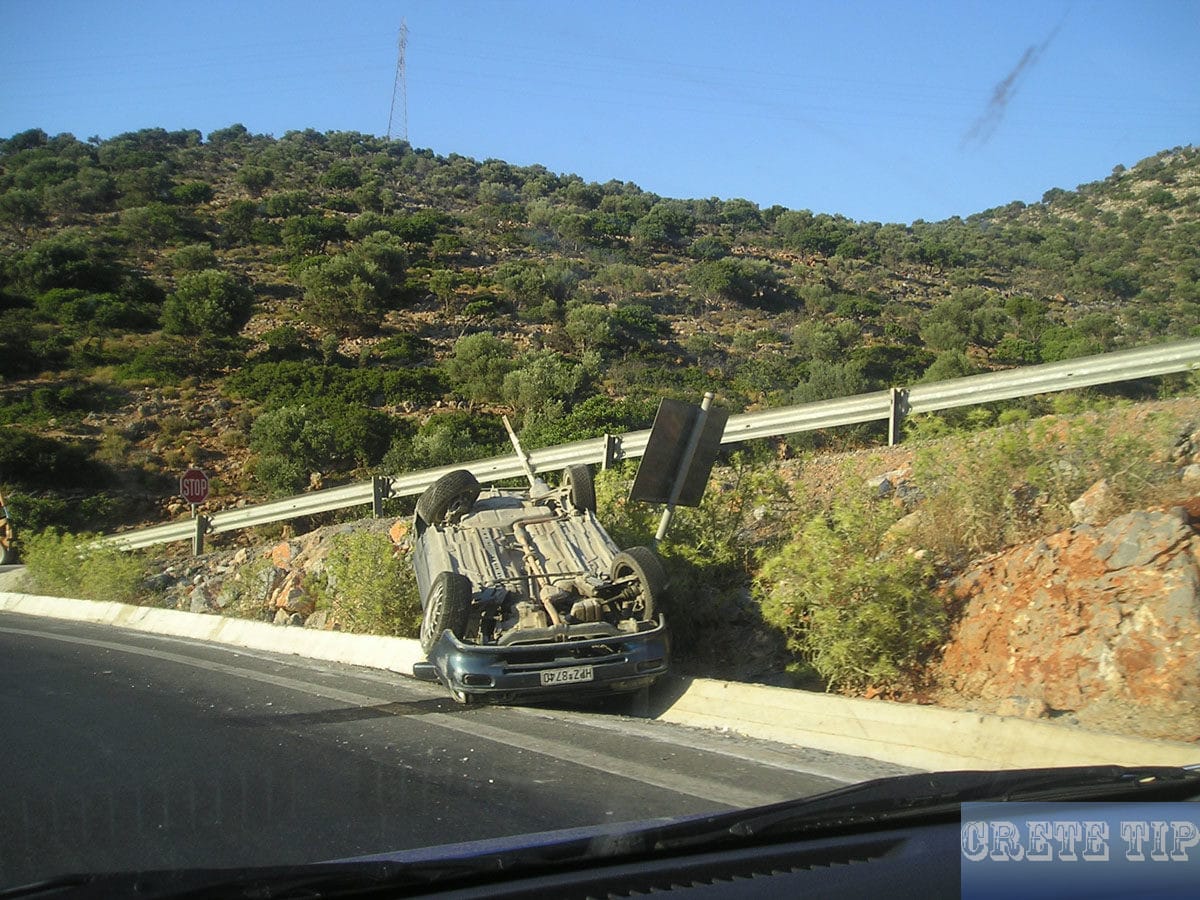News from the traffic front on Crete: sad first place for Rethymnon in traffic accidents, the police department of Chania is dissolved after a fatal traffic accident at the weekend and a stricter road traffic regulation is in preparation.

Sad Leadership of Rethymno in Traffic Accidents
Table of Contents
In recent discussions, Giannis Lionakis, the president of the Volunteer Association for the Prevention of Traffic Accidents, has highlighted the alarming situation in Rethymno regarding road safety. The year 2024 proved to be particularly challenging, with an unfortunate record of 64 fatalities due to traffic incidents across Crete. Of these, 13 deaths occurred in Rethymno, translating to a shocking rate of 156 deaths per million residents. This grim statistic positions Rethymno at the forefront of the region’s traffic accidents, with a stark reality that must be addressed.
In comparison, other areas in Crete experienced fewer incidents. Chania reported 23 fatalities, equating to 148 per million residents, while Heraklion had 78 per million. Lassithi, known for its calmer traffic environment, had only five deaths, or 69 per million. Rethymno now ranks among the three most dangerous regions in Greece for traffic incidents, making this a pressing issue for local authorities and the community.
A significant factor contributing to Rethymno’s traffic troubles appears to be the urban design of the city and its outskirts, particularly around areas like Stavromenos. Recent months saw a spike in fatal accidents, with three occurring within just one month in the Skafaki area. This has raised urgent calls for improved safety measures, spotlighting the need for a new highway, the BOAK (North Road Axis of Crete).
The national figures further emphasise the severity of the situation. Crete is on track to conclude the year with a fatality rate of approximately 72-73 deaths, which is more than double the average for the country and three times the European average. This trend underscores deeply ingrained issues that plague the Greek society regarding road safety, signalling a need for serious reflection and action, rather than mere aspirations for change.
With the impact of COVID-19 still felt across various sectors, public authorities are now challenged to rethink traffic safety measures. The pandemic has shaped behaviours and expectations, making proactive initiatives for traffic accident prevention more critical than ever.
Lionakis stresses that addressing these issues requires a shift from discussions to tangible actions. This includes not only enhancing infrastructure but also promoting a culture of preventive measures. Efforts should ideally involve community engagement and education about safety gear, such as the importance of wearing helmets and seat belts.
Chania Police Headquarters Department Disbanded Following Fatal Weekend Traffic Accident
The Chania Police Headquarters Department has been dismantled on the orders of Prime Minister Kyriakos Mitsotakis. This decision follows a tragic incident on Saturday in Souda, where a 22-year-old lost his life after his vehicle collided with another driven by a 45-year-old man. Reports indicate that the older driver had previously tested positive for alcohol.
Further investigation revealed that the driver responsible for the crash claimed he did not possess his driving licence. However, it was later discovered that his licence had been revoked earlier due to prior incidents involving alcohol. This situation has raised concerns about the effectiveness of local law enforcement in managing drunk driving cases.
In light of the accident and the handling of the responsible driver by local police, the Prime Minister’s directive has led to a complete overhaul of the department. Future replacements for the current officers will be sourced from Athens, as detailed by various media outlets.
Minister of Citizen Protection Michalis Chrisochoidis expressed deep sorrow over the loss of a young life, stating, “A boy, a child of 22 years, has been lost. He is everyone’s child; this is a tragedy.” He emphasised the importance of all police personnel performing their duties properly. Additionally, he stressed that sanctions will be imposed on those responsible for any lapses in oversight or administrative responsibility regarding the incident.
In conjunction with these developments, officials from the Chania Prosecutor’s Office have clarified that there has been no official directive to prevent police from arresting intoxicated drivers. Following their review of the facts surrounding the fatal accident, they have ordered the formation of a case against the involved police officers. These officers will undergo questioning before the appropriate prosecutor, and an urgent preliminary investigation has been initiated to explore the circumstances surrounding the incident.
The fatal collision has brought to light ongoing issues with drunk driving in the region, prompting deeper reflections on public safety and law enforcement practices. The community is now faced with seeking answers and accountability as they grapple with the aftermath of this devastating event.
Stricter Road Traffic Regulations in Preparation
The new Road Traffic Code is set to enter public consultation in the Greek Parliament until 24 January, following which it is expected to be voted on and implemented around mid-spring. The proposed changes aim to enhance road safety and protect human life while adapting to current mobility trends and technological advancements. This includes a gradual digitisation of processes.
In addition, the intent is to address the noticeable lack of driver education and reduce misuse of the roads. This involves ensuring that all road users, including pedestrians and cyclists, are protected and that their safety is prioritized. Furthermore, the new regulations seek to eliminate behaviours that risk the safety of others, whether through obstructions that limit visibility or by carelessly leaving materials on the road.
Key Changes to Expect
A major difference with the new regulations is how penalties are applied. Penalties will now target the driver rather than the vehicle. This means that vehicle registrations and licences will not be revoked, even in cases of violations. This change aims to recognise that a vehicle might be used by multiple people, not just the violator.
Penalties for Pedestrians
There is also a significant shift regarding penalties for pedestrians. Previously, pedestrians often escaped fines for infractions. Under the new code, this will change. For instance, if a pedestrian disregards a red traffic light, they may face a fine of €30. This is part of a broader initiative to ensure safety across all users.
In contrast, drivers who run a red light face far stricter consequences, with fines reaching up to €700 and a 30-day licence suspension. Similarly, ignoring a stop sign will incur the same penalties. Violations like these are deemed to have serious effects on road safety and fall into the E4 category.
Speed Limit Violations
Speeding, especially exceeding the limit by more than 50 km/h, also falls under this stricter regulation. In these cases, a driver could lose their licence for up to 90 days. Driving under the influence of alcohol presents severe penalties as well. When blood alcohol content is between 0.80 g/l and 1.10 g/l, a driver may face hefty fines and potential license suspension.
Digital Transformation of Procedures
As noted, the gradual digitisation of road traffic regulations is a goal of the new code. This transformation is set to enhance efficiency and tracking of infractions. The move towards digital processes will simplify the way traffic regulations are enforced and help in training drivers.
Promoting Road Safety
Proponents of the new code argue that it will lead to safer roads and less reckless behaviour. Educating drivers and pedestrians about their responsibilities can potentially decrease the number of traffic-related accidents. Enhancing drivers’ awareness of road rules and encouraging safe practices could ultimately reduce casualties.
Conclusion on the Need for Change
The combination of advancements in technology and a better understanding of road behaviour forms a foundation for implementing these new strategies. The government’s recognition of changing dynamics on the roadway is vital in tackling future road safety challenges.
Frequently Asked Questions
What causes Rethymno to have the highest number of road accidents?
Several factors contribute to the increased rate of road accidents in Rethymno. These include heavy traffic, lack of proper signage, and challenging road conditions. Additionally, driver behaviour, such as speeding and distracted driving, plays a significant role.
How does Rethymno’s road safety compare to other areas?
When comparing Rethymno’s road infrastructure to other regions, it appears to have certain deficiencies. The roads may not be as well-maintained or equipped with safety features like guard rails and adequate lighting. These issues can increase the risk of accidents.
What actions are being taken to reduce traffic accidents in Rethymno?
Local authorities have initiated various measures to address the high number of traffic accidents. These actions include improving road conditions, increasing police presence, and implementing stricter traffic regulations to enhance safety.
What is the role of local officials in traffic safety management in Rethymno?
Local officials play a crucial role in managing traffic safety in Rethymno. They are responsible for policy-making, enforcing traffic laws, and promoting safety initiatives that aim to reduce accident rates.
Are there any public awareness campaigns focused on lowering traffic accidents in Rethymno?
Yes, there are various educational campaigns aimed at raising awareness about road safety in Rethymno. These initiatives target drivers, pedestrians, and cyclists, emphasising safe practices and the importance of obeying traffic regulations.






